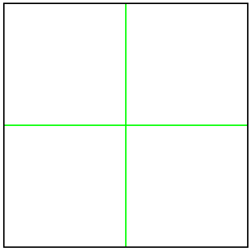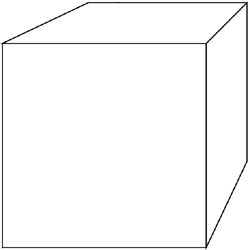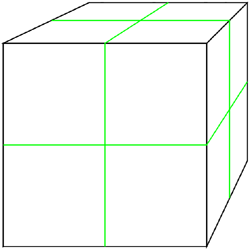P = N, S = N
Linear algebra gives a clear definition of the dimension of a vector space. It is the number of linearly independent vectors required such that the span of those vectors is exactly the same as the set of all vectors in the space. But what about the dimension of a finite object? The set of all linear combinations of any set of vectors will then contain vectors that are outside of the object. We would like a way to define the dimension of such finite objects.
The dimension of some objects seems obvious. For example, most people would say that a finite straight line is one-dimensional. (Of course, an infinite straight line is a vector space and linear algebra tells us that it is certainly one-dimensional.) Similarly, it seems clear to most that a square on the x-y plane is two-dimensional and a cube in the x-y-z space is three-dimensional. But what about a curved line on the x-y plane? It is still a line, but to some it may seem two-dimensional because it requires two "directions", say up-down and left-right. How about a curved line or a plane in the x-y-z space? And then of course there are more complex objects. What is the dimension of a fractal?
The concept of the dimension of an object may be purely a human construct. We explore below a definition of it for self-similar objects, but on the whole it seems to be purely subjective. (A self-similar object is one that looks about the same on any scale.) One clearly desirable aspect of the definition is that it agrees with the intuitive results for simple objects. It determines the dimension of a line as 1, that of a square as 2, and that of a cube as 3. It can then be extended to other finite objects.
Take a straight line and cut it in half. We now have two self-similar copies of the original line, each of which can be scaled by a factor of 2 to yield the original line. We call this the scaling factor of the smaller copies of the line. We could cut the line into any number N of equal pieces, and the scaling factor for each would be N. Now take a square and cut it into 4 congruent squares. Here we have 4 copies of the original square with a scaling factor of 2. We can split the square into any number N^2 self-similar copies with scaling factor N. Similarly, a cube can be split into N^3 self-similar copies with scaling factor N. The division of these simple objects is illustrated below.
Straight Line |
P = 2, S = 2 P = N, S = N |
 |
 |
|
Square |
P = 4, S = 2 P = N^2, P = N |
 |
 |
|
Cube |
P = 8, S = 2 |
We can thus define the dimension of a line as 1, a square as 2, and a cube as 3. To extract the dimension, we set P to be the number of self-similar pieces, S to be the scaling factor, and d to be the dimension, and we have:

As examples, we apply this formula to our simple objects:
For a line, we can choose the number of self-similar pieces P as 2 and the scaling factor S as 2. Then the dimension is log(2)/log(2) = 1. If we cut the line into N pieces, the scaling factor will be N, and the dimension will be log(N)/log(N) = 1.
If we cut a square into 4 congruent pieces, the scaling factor is 2 and the dimension is log(4)/log(2) = 2. Similarly, if we cut the square into N^2 congruent pieces, the scaling factor will be N, and the dimension will be log(N^2)/log(N) = 2log(N)/log(N) = 2.
Finally, a cube can be cut into N^3 congruent pieces with scaling factor N, giving dimension d = log(N^3)/log(N) = 3log(N)/log(N) = 3.
The result of this formula for a given object is called the object's capacity dimension or Hausdorff dimension, after the German mathematician Felix Hausdorff. The next pages demonstrate the use of this formula in determining the capacity dimension of various Lindenmayer fractals.